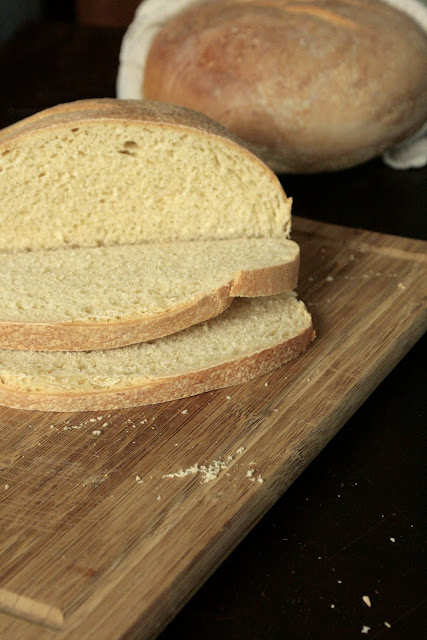Friends, I have finally put my sourdough starter to use! And I remembered to take pictures for all of you before the loaves got greedily gobbled.
Herbert has made some delicious bread, I am pleased.
Herbert is my sourdough starter, I'm not totally bonkers or anything (sort of). If you would also like a Herbert, check out my sourdough starter posts! Day 1 has the starter recipe and instructions, Day 2 shows Herbert in the inbetween stages, and Day 3 he's all bubbly and happy and yeasty.
It was a wild yeast hunt, and I highly recommend it.
Well, maybe not, I wrote a poem for school and my mom thought I copied it from a book. Minor bragging there, whatevs.
But anyway, this bread is such a no-brainer for me, I've made it many (four) times.
It is crusty, with a soft interior. It is bread. And it is good.
I'm not doing a good job at getting into this.
Well here's something, it makes a danged good sandwich. Truth.
Oh yeah, it's an overnight thing too. Make sure you time it right, unless you want to get up at midnight to bake your risen loaves. Planning, you can do it! I believe in you.
Before you do any of that, you need a starter. Because that's where it all...starts. Kay bye.
Sourdough Bread
Yield: 2 large, round loaves
Ingredients:
- 1½ cups lukewarm water (100˚ F)
- 4 tsp. active dry or instant yeast
- 1 tbsp. honey
- 1 cup sourdough starter
- 5½-6 cups bread flour, plus more as needed
- 1 tbsp. unsalted butter, melted
- 2 large eggs, at room temperature
- 2½ tsp. salt
- 1 tbsp. bread flour mixed with 1 tbsp. yellow cornmeal
Directions:
In the bowl of an electric mixer, whisk together the water, yeast, honey, and sourdough starter just until smooth. Cover with plastic wrap and let stand at room temperature until slightly increased in bulk and bubbly, about 1 hour.
With the flat beater attached to the mixer and the mixer on low speed, mix in 3 cups of the flour, the butter, eggs and salt. Increase the speed to medium-low and mix until smooth, about 1 minute. Add in 2 more cups of the flour and beat for 2 minutes.
Switch to the dough hook. With the mixer on low speed, add the remaining flour, ¼ cup at a time, until a very soft dough forms that pulls away from the sides of the bowl. Knead on low speed, adding a tablespoon of flour if the dough begins to stick, until the dough is smooth and elastic, tacky but not sticky, about 6 minutes. Form the dough into a ball and transfer to a lightly oiled bowl, turning once to coat. Cover loosely with plastic wrap and let rise until doubled in bulk, about 1½-2 hours.
Line a baking sheet with parchment paper. Sprinkle generously with the cornmeal-flour mixture. Turn the dough onto a lightly floured surface. Divide the dough into two equal portions and form each into a tight, oval loaf. Place the loaves on the prepared baking sheet, several inches apart. Sprinkle the tops with flour and gently rub in. Cover loosely with plastic wrap and let rise in the refrigerator, 8-12 hours.
Place a baking stone on the lowest oven rack and preheat the oven to 450˚ F. (If you don’t have a baking stone, use an overturned baking sheet.) Using a thin sharp knife, make three slash marks over the top of each loaf. Place the baking sheet on the heated baking stone and bake for 10 minutes. Reduce the oven temperature to 400˚ F and continue to bake until the loaves are golden brown, 25-30 minutes more. Let cool completely on a wire rack before slicing and serving.
Sources: adapted from Annie's Eats, originally from Williams-Sonoma






